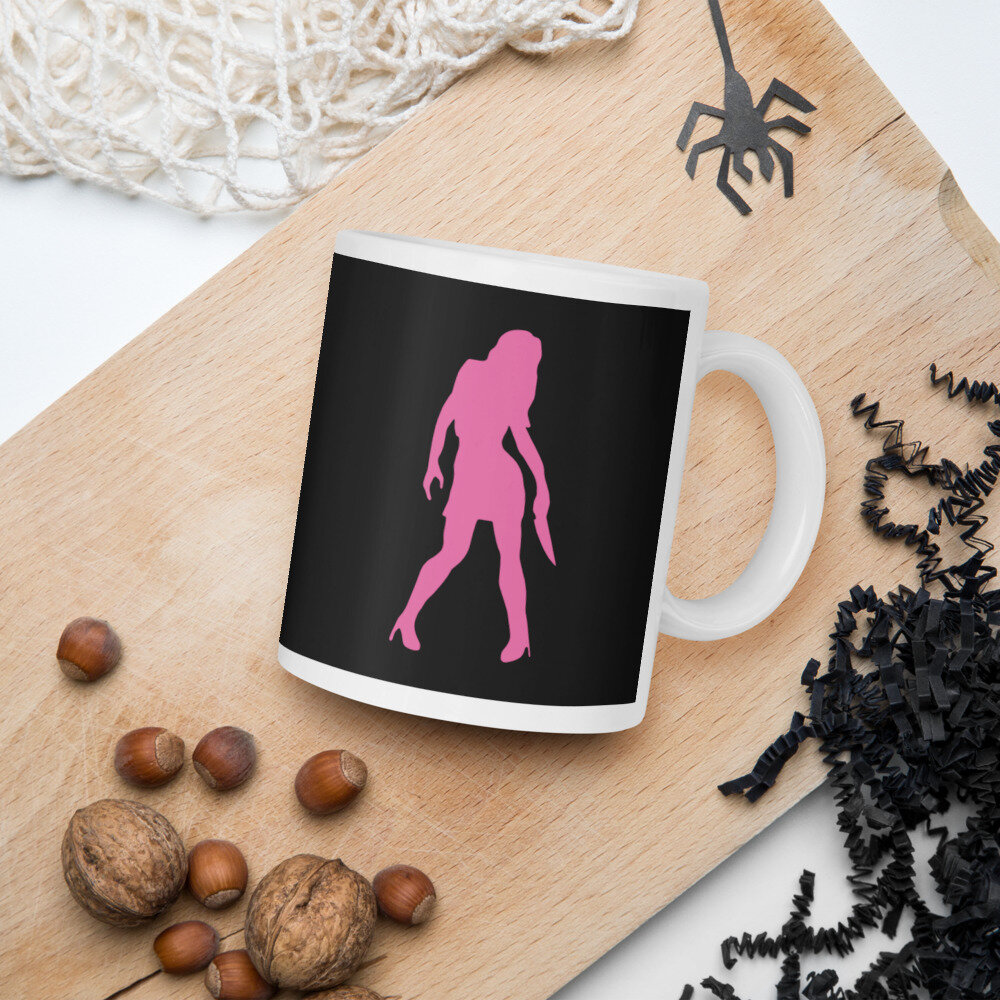[Editorial] Ms .45 (40 Years On) - (1981)

Ms .45 (1981), also known as Angel of Vengeance, examines a woman’s life shattered by rape and transformed into vigilantism. The film infuses the exploitation genre with meaning as the sleazy streets of New York City are the setting for a rape-revenge tale like no other.
Directed by Abel Ferrara and written by Nicholas St. John, the writer for several other Ferrara-directed films including Driller Killer (1979) and Body Snatchers (1993), Ms .45 not only still holds up forty years on but is also highly relevant in today’s #metoo culture. The low budget lends a gritty look and tone to the film which pairs perfectly with the subject matter. The score by Joe Delia, another long-time collaborator of Ferrara, emphasises the impact of the protagonist’s journey.
Thana (Zoe Lund) works for a small fashion company in the garment district. She is shy and mute, and has a somewhat friendly relationship with her co-workers but is otherwise a rather solitary character. The seamstresses finish work and face catcalls as they walk down the street; an unavoidable barrage of predatory looks and sexual advances. She declines her co-workers’ offer of joining them to go out for drinks and takes the subway home. On her way, Thana takes a trip to the supermarket and selects an item from the meat section, mirroring how the men on the street view her and the other women. Then, before she reaches her apartment, she is dragged into an alley by a masked man who rapes her at gunpoint; the viewer witnessing the horror of the crime and Thana’s shock and bewilderment.
Finally, she enters her apartment, locking the door behind her, safe in her own space only to find it has been invaded by a burglar and once again she is held at gunpoint and raped. Thana defends herself by hitting him with a red glass apple, a symbol evoking both Eve in the Garden of Eden and the Evil Queen from Snow White, then finishing him off with a bash from an iron. Unsure of what to do next, she drags the body to the bathroom and puts it in the bath. She also pockets the gun.
The following day she goes to work as usual and is struck with an idea of what to do with the body. On returning home she dismembers the corpse and packages it up in multiple pieces which she begins to dispose of around the city. On one such trip she is chased by a man who corners her in the dead end of an alley. Out of fear of what might happen next, Thana grabs the gun and shoots the would-be attacker. This marks a turning point for her as in this instance she is the one wielding the power.

Thana suffers from PTSD, haunted by visions of her rapist returning. She no longer feels safe anywhere as sheh at the mercy of everyone around her, on the streets, in the workplace and even at home where she receives uninvited visits from her nosy landlady. Unable to take the time to process the traumatic events she is forced to carry on with daily life, one day at work writing a heart-breaking note that says “I just wish they would leave me alone”.
Instead of breaking down, Thana decides to fight back. She takes to the streets to wipe out predators, potential rapists, any man who might try to take advantage of her or any other woman. Her actions go beyond revenge against her attackers. In this way Ms .45 differs from many other rape-revenge movies, such as The Last House on the Left (1972) and I Spit on Your Grave (1978), which focus on revenge against specific people. Thana is a one-woman crusader trying to protect not only herself but all women. If she were here today she would be firmly in the #yesallmen camp.
Embracing her feminine power, Thana accentuates her looks and figure to the degree that she is almost unrecognisable from her unassuming style at the start of the film. Luring men to their demise, her weapon is the .45 calibre pistol previously owned by her rapist; using the very thing that was used against her and turning the tables on future would-be attackers. Her experience tells her that men are only after one thing and will take it by force so in order to exert agency on the situation she has to resort to deadly measures in an effort to prevent the inevitable.
The climax of the film takes place at a Halloween party with all the attendees in costume. The viewer watches Thana in her apartment getting ready, wearing her nun outfit and red lipstick, aiming her gun around the room and play-acting her plan for the night. Once at the party, Thana’s boss makes a move on her which gives her all the justification she needs to start shooting. The upbeat music gives way to distorted voices and noise as the scene plays out in chilling slow motion.

As Thana aims the gun at the crowd her co-worker behind her grabs a knife, wielding it in front of her crotch like a penis and it is this very weapon being the one to take her down, echoing the masculine threat that triggered this whole chain of events. Recognising the assailant as her co-worker, Thana doesn’t retaliate but instead whispers the word “sister” as she falls to the floor. At this point the viewer knows that the police are trying to track her down in connection with the body parts found around the city so her vigilantism was bound to come to an end one way or another but her demise is both shocking and sad.
Thana’s behaviour, while extreme, can be something of a cathartic experience for viewers who have been through similar experiences to the character. Anyone who has been catcalled, demeaned or assaulted in any kind of sexual manner could live vicariously through Thana’s actions and claim back their confidence and power on the back of her vengeance. While Thana’s battle came to an end, the fight against misogyny is still worth fighting.
Ms .45 is unquestionably still powerful and relevant today. While four decades have passed since its release, the daily sexism and misogyny that women face has not changed much. At a taut eighty minutes, the film is an uncompromising look at rape culture, revenge and feminism that is unique in its style and is highly deserving of a first time watch or a revisit today.
Many of the most effective horror films involve blurring the lines between waking life and a nightmare. When women in horror are emotionally and psychologically manipulated – whether by other people or more malicious supernatural forces – viewers are pulled into their inner worlds, often left with a chilling unease and the question of where reality ends and the horror begins.
Looking for some different slasher film recommendations? Then look no fruther as Ariel Powers-Schaub has 13 non-typical slasher horror films for you to watch.
In the sweaty summer of 1989, emerging like a monochrome migraine from the encroaching shadow of Japan’s economic crash, Shin’ya Tsukamoto’s Tetsuo: The Iron Man shocked and disgusted the (very few) audiences originally in attendance.
The human body is a thing of wonder and amazement–the way it heals itself, regenerates certain parts and can withstand pain and suffering to extreme extents. But the human body can also be a thing of disgust and revulsion–with repugnant distortions, oozing fluids and rotting viscera.
Body horror is one of the fundamental pillars of the horror genre and crops up in some form or another in a huge variety of works. There's straightforward gore - the inherent horror of seeing the body mutilated, and also more nuanced fears.
When people think of horror films, slashers are often the first thing that comes to mind. The sub-genres also spawned a wealth of horror icons: Freddy, Jason, Michael, Chucky - characters so recognisable we’re on first name terms with them. In many ways the slasher distills the genre down to some of its fundamental parts - fear, violence and murder.
The year was 1968 and a young man named George A. Romero had shot his first film, a horror movie that would change the world of cinema and not just horror cinema, at that. Night of the Living Dead (1968), would go on to become one of the most important and famous horror films of all time as it tackled not only survival horror but also very taboo and shocking topics like cannibalism and matricide.
On Saturday, 17th June 2023, I sat down with two friends to watch The Human Centipede (First Sequence) (2009) and The Human Centipede 2 (Full Sequence) (2012). I was nervous to be grossed out (I can’t really handle the idea of eating shit) but excited to cross these two films off my list.
This June we’ve been looking at originals and their remakes—and whilst we don’t always agree with horror film remakes, some of them often bring a fresh perspective to the source material. For this episode, we are looking at the remake of one of the most controversial exploitation films, The Last House on the Left (2009).
Throughout September we were looking at slasher films, and therefore we decided to cover a slasher film that could be considered as an underrated gem in the horror genre. And the perfect film for this was Franck Khalfoun’s 2012 remake of MANIAC.
I can sometimes go months without having a panic attack. Unfortunately, this means that when they do happen, they often feel like they come out of nowhere. They can come on so fast and hard it’s like being hit by a bus, my breath escapes my body, and I can’t get it back.
But some of the most terrifying horrors are those that take place entirely under the skin, where the mind is the location of the fear. Psychological horror has the power to unsettle by calling into question the basis of the self - one's own brain.
In the end I decided to indulge myself by picking eight of my favourite shorts, and choosing features to pair with them that would work well as a double bill. The pairs might be similar in tone, subject or style; some of the shorts are clearly influenced by their paired movie, while others predate the features.
Whether it's the havoc wreaked on the human body during pregnancy, emotional turmoil producing tiny murderous humans or simply a body turning on its owner, body horror films tend to be shocking. But while they're full of grotesque imagery, they're also full of thoughtful premises and commentary, especially when it comes to women, trauma, and power.
Even though they are not to my personal liking, there is no denying that slasher films have been an important basis for the horror genre, and helped to build the foundations for other sub-genres throughout the years.

RELATED ARTICLES
Filmdom’s conventional wisdom in the mid-20th Century decreed that horror was no place for a lady. That is, unless it was as a shrieking victim dressed in a bosom-baring, diaphanous nightie…
It’s not wholly obvious in the first thirty minutes of Tobe Hooper’s The Texas Chainsaw Massacre just who our final girl will be…
Mary Harron’s American Psycho has had a strange and convoluted path to its current position as a lauded part of the American horror canon…
Helen Lyle is a triple threat. She is smart, charismatic and tenacious. An innovative researcher who wants to push the envelope. ..
When reassessing The Exorcist, there are implications of abuse brought on by Chris MacNeil’s reluctance to be a proper ‘mother’ to Regan…
Possessor is a slick futuristic thriller in which Tasya Vos, an assassin for hire, must manage her responsibilities as an elite killing machine and complex feelings towards her husband and son, whilst taking on another high-profile job that will push her to the edge of her sanity.
When James Wan’s The Conjuring (2013) was first released, it set the tone for 2010s horror and was regarded by some horror fans as the beginning of a renaissance for the genre…
The Babadook is a 2014 psychological horror, the directorial debut of Jennifer Kent…
Everyone must play, no outsiders allowed, nobody leaves.
Sara is host of a failing web series entitled Encounters which shows her meeting a range of offbeat people through personal ads…
Sara is a woman condemned from the start, first because of her religious beliefs…

EXPLORE
Being able to see into the future or back into the past is a superpower that a lot of us would like to have. And while it may seem cool, in horror movies it usually involves characters being sucked into terrifying situations as they try to save themselves or other people with the information they’ve gleaned in their visions.
Both the original Pet Sematary (1989) and its 2019 remake are stories about the way death and grief can affect people in different ways. And while the films centre on Louis Creed and his increasingly terrible decision-making process, there’s no doubt that the story wouldn’t pack the same punch or make the same sense without his wife, Rachel.
In the six years since its release the Nintendo Switch has amassed an extensive catalogue of games, with everything from puzzle platformer games to cute farming sims to, uh, whatever Waifu Uncovered is.
Now it’s time for Soho’s main 2023 event, which is presented over two weekends: a live film festival at the Whirled Cinema in Brixton, London, and an online festival a week later. Both have very rich and varied programmes (with no overlap this year), with something for every horror fan.
Mother is God in the eyes of a child, and it seems God has abandoned the town of Silent Hill. Silent Hill is not a place you want to visit.
If you like cults, sacrificial parties, and lesbian undertones then Mona Awad’s Bunny is the book for you. Samantha, a student at a prestigious art university, feels isolated from her cliquey classmates, ‘the bunnies’.
A Quiet Place (2018) opens 89 days after a race of extremely sound-sensitive creatures show up on Earth, perhaps from an exterritorial source. If you make any noise, even the slightest sound, you’re likely to be pounced upon by these extremely strong and staggeringly fast creatures and suffer a brutal death.
The slasher sub genre has always been huge in the world of horror, but after the ‘70s and ‘80s introduced classic characters like Freddy Krueger, Michael Myers, Leatherface, and Jason, it’s not harsh to say that the ‘90s was slightly lacking in the icon department.


![[Editorial] Top 15 Female-Focused Mind Horror Films](https://images.squarespace-cdn.com/content/v1/5fe76a518d20536a3fbd7246/1691247166903-S47IBEG7M69QXXGDCJBO/Image+5.jpg)
![[Editorial] Deeper Cuts: 13 Non-Typical Slashers](https://images.squarespace-cdn.com/content/v1/5fe76a518d20536a3fbd7246/1694951568990-C37K3Z3TZ5SZFIF7GCGY/Curtains-1983-Lesleh-Donaldson.jpg)
![[Editorial] Metal Heart: Body Dysmorphia As A Battle Ground In Tetsuo: The Iron Man (1989)](https://images.squarespace-cdn.com/content/v1/5fe76a518d20536a3fbd7246/1690190127461-X6NOJRAALKNRZY689B1K/Screenshot+2023-07-24+at+10.08.27.png)
![[Editorial] Editor’s Note: Getting sticky, slimy & sexy with body horror](https://images.squarespace-cdn.com/content/v1/5fe76a518d20536a3fbd7246/1689072388373-T4UTVPVEEOM8A2PQBXHY/Society-web.jpeg)
![[Editorial] 8 Body Horror Short films](https://images.squarespace-cdn.com/content/v1/5fe76a518d20536a3fbd7246/1690838270920-HWA5RSA57QYXJ5Y8RT2X/Screenshot+2023-07-31+at+22.16.28.png)
![[Editorial] 5 Slasher Short Horror Films](https://images.squarespace-cdn.com/content/v1/5fe76a518d20536a3fbd7246/1696358009946-N8MEV989O1PAHUYYMAWK/Screenshot+2023-10-03+at+19.33.19.png)
![[Editorial] They’re Coming to Re-Invent You, Barbara! Night of the Living Dead 1968 vs Night of the Living Dead 1990](https://images.squarespace-cdn.com/content/v1/5fe76a518d20536a3fbd7246/1687199945212-BYWYXNBSH00C4V3UIOFQ/Screenshot+2023-06-19+at+19.05.59.png)
![[Editorial] Eat Shit and Die: Watching The Human Centipede (2009) in Post-Roe America ](https://images.squarespace-cdn.com/content/v1/5fe76a518d20536a3fbd7246/1691245606758-4W9NZWE9VZPRV697KH5U/human_centipede_first_sequence.original.jpg)
![[Ghouls Podcast] The Last House on the Left (2009) with Zoë Rose Smith and Jerry Sampson](https://images.squarespace-cdn.com/content/v1/5fe76a518d20536a3fbd7246/1687863043713-54DU6B9RC44T2JTAHCBZ/last+house+on+the+left.jpg)
![[Ghouls Podcast] Maniac (2012) with Zoë Rose Smith and Iona Smith](https://images.squarespace-cdn.com/content/v1/5fe76a518d20536a3fbd7246/1696356006789-NYTG9N3IXCW9ZTIJPLX2/maniac.jpg)
![[Editorial] “I control my life, not you!”: Living with Generalised Anxiety Disorder and the catharsis of the Final Destination franchise](https://images.squarespace-cdn.com/content/v1/5fe76a518d20536a3fbd7246/1696444478023-O3UXJCSZ4STJOH61TKNG/Screenshot+2023-10-04+at+19.30.37.png)
![[Editorial] 8 Mind Horror Short films](https://images.squarespace-cdn.com/content/v1/5fe76a518d20536a3fbd7246/1693504844681-VPU4QKVYC159AA81EPOW/Screenshot+2023-08-31+at+19.00.36.png)
![[Editorial] 8 Short & Feature Horror Film Double Bills](https://images.squarespace-cdn.com/content/v1/5fe76a518d20536a3fbd7246/1687770541477-2A8J2Q1DI95G8DYC1XLE/maxresdefault.jpeg)
![[Editorial] Top 15 Female-Focused Body Horror Films](https://images.squarespace-cdn.com/content/v1/5fe76a518d20536a3fbd7246/1689081174887-XXNGKBISKLR0QR2HDPA7/download.jpeg)
![[Editorial] Editor’s Note: Making a slash back into September](https://images.squarespace-cdn.com/content/v1/5fe76a518d20536a3fbd7246/1694354202849-UZE538XIF4KW0KHCNTWS/MV5BMTk0NTk2Mzg1Ml5BMl5BanBnXkFtZTcwMDU2NTA4Nw%40%40._V1_.jpg)
![[Editorial] Margaret Robinson: Hammer’s Puppeteer](https://images.squarespace-cdn.com/content/v1/5fe76a518d20536a3fbd7246/1630075489815-33JJN9LSGGKSQ68IGJ9H/MV5BMjAxMDcwNDI2Nl5BMl5BanBnXkFtZTcwOTMxODgzMQ%40%40._V1_.jpg)
![[Editorial] Sally Hardesty in The Texas Chainsaw Massacre (1974)](https://images.squarespace-cdn.com/content/v1/5fe76a518d20536a3fbd7246/1637247162929-519YCRBQL6LWXXAS8293/the-texas-chainsaw-final-girl-1626988801.jpeg)
![[Editorial] American Psycho (2000)](https://images.squarespace-cdn.com/content/v1/5fe76a518d20536a3fbd7246/1627317891364-H9UTOP2DCGREDKOO7BYY/american-psycho-bale-1170x585.jpg)
![[Editorial] In Her Eyes: Helen Lyle in Candyman (1992)](https://images.squarespace-cdn.com/content/v1/5fe76a518d20536a3fbd7246/1649586854587-DSTKM28SSHB821NEY7AT/image1.jpg)
![[Editorial] Re-assessing The Exorcist: Religion, Abuse, and The Rise of the Feminist Mother.](https://images.squarespace-cdn.com/content/v1/5fe76a518d20536a3fbd7246/1629995626135-T5K61DZVA1WN50K8ULID/image2.jpg)
![[Editorial] In Her Eyes: Tasya Vos in Possessor (2020)](https://images.squarespace-cdn.com/content/v1/5fe76a518d20536a3fbd7246/1667061747115-NTIJ7V5H2ULIEIF32GD0/Image+1+%285%29.jpg)
![[Editorial] Lorraine Warren’s Clairvoyant Gift](https://images.squarespace-cdn.com/content/v1/5fe76a518d20536a3fbd7246/1648576580495-0O40265VK7RN03R515UO/Image+1+%281%29.jpg)
![[Editorial] The Babadook (2014)](https://images.squarespace-cdn.com/content/v1/5fe76a518d20536a3fbd7246/1651937631847-KR77SQHST1EJO2729G7A/Image+1.jpg)
![[Editorial] Unravelling Mitzi Peirone’s Braid (2018)](https://images.squarespace-cdn.com/content/v1/5fe76a518d20536a3fbd7246/1628359114427-5V6LFNRNV6SD81PUDQJZ/4.jpg)
![[Editorial] Sara in Creep 2 (2017)](https://images.squarespace-cdn.com/content/v1/5fe76a518d20536a3fbd7246/1646478850646-1LMY555QYGCM1GEXPZYM/27ebc013-d50a-4b5c-ad9c-8f8a9d07dc93.jpg)
![[Editorial] In Her Eyes: Sara Lowes in Witchfinder General (1968)](https://images.squarespace-cdn.com/content/v1/5fe76a518d20536a3fbd7246/1655655953171-8K41IZ1LXSR2YMKD7DW6/hilary-heath.jpeg)





















![[Editorial] 9 Terrifying Cerebral Visions in Horror Movies](https://images.squarespace-cdn.com/content/v1/5fe76a518d20536a3fbd7246/1693509801235-X23OL50T1DVGECH0ZJK2/MV5BMjQ0MTg2MjQ4MV5BMl5BanBnXkFtZTgwMTU3NDgxMTI%40._V1_.jpg)
![[Mother of Fears] I Don’t Wanna Be Buried in a Pet Sematary (1989) and (2019)](https://images.squarespace-cdn.com/content/v1/5fe76a518d20536a3fbd7246/1691328766069-QFNAVJOMFZVZ5CLU1RWM/Screenshot+2023-08-06+at+14.23.13.png)
![[Editorial] 9 Horror Nintendo Switch Games To Play](https://images.squarespace-cdn.com/content/v1/5fe76a518d20536a3fbd7246/1697214470057-3XZXX8N4LYIMDFWS6Z3P/Screenshot+2023-10-13+at+17.20.13.png)
![[Editorial] 10 Films & Events to Catch at Soho Horror Film Fest 2023](https://images.squarespace-cdn.com/content/v1/5fe76a518d20536a3fbd7246/1700819417135-299R7L4P0B676AD3RO1X/Screenshot+2023-11-24+at+09.41.52.png)
![[Mother of Fears] Mother Vs. Monster in Silent Hill (2006)](https://images.squarespace-cdn.com/content/v1/5fe76a518d20536a3fbd7246/1695485781119-H6GNP0G3J2TLPAOIABV7/Screenshot+2023-09-23+at+17.11.56.png)
![[Editorial] 5 Female Focused Horror Book Recommendations](https://images.squarespace-cdn.com/content/v1/5fe76a518d20536a3fbd7246/1696441981361-52EQCTJ7AT2QF1927GM7/919xtm6d3fL._AC_UF894%2C1000_QL80_.jpg)
![[Mother of Fears] Mothering in Silence in A Quiet Place (2018)](https://images.squarespace-cdn.com/content/v1/5fe76a518d20536a3fbd7246/1696445921315-HZJ2DZYQIH6VVWXBO2YL/Screenshot+2023-10-04+at+19.52.29.png)
![[Editorial] 9 Best Slashers Released Within 10 Years of Scream (1996)](https://images.squarespace-cdn.com/content/v1/5fe76a518d20536a3fbd7246/1695478839037-LOFHGVM3H6BMSZW7G83M/Screenshot+2023-09-23+at+15.15.11.png)

In the late seventies and early eighties, one man was considered the curator of all things gore in America. During the lovingly named splatter decade, Tom Savini worked on masterpieces of blood and viscera like Dawn of the Dead (1978), a film which gained the attention of hopeful director William Lustig, a man only known for making pornography before his step into horror.